Pig farmers unexpectedly increased their income by nearly 200 million VND per year just by changing the type of feed. So what is this secret, and why is it so effective?
This food sounds mysterious, but is surprisingly familiar...
According to Dr. Kim Jae Cheol, Director of the Asia- Pacific Technical Solutions Center, in the 1950s and 1960s, when science and technology were not yet developed, the livestock industry still relied solely on crude protein analysis in feed. At that time, crude protein was considered the main indicator to evaluate the nutritional quality of pigs, while amino acids and the digestibility of livestock were still unexplored areas.
It was not until 1990, with scientific advances, that researchers gradually perfected their knowledge of amino acid digestibility and came up with a more suitable crude protein balance formula for livestock.
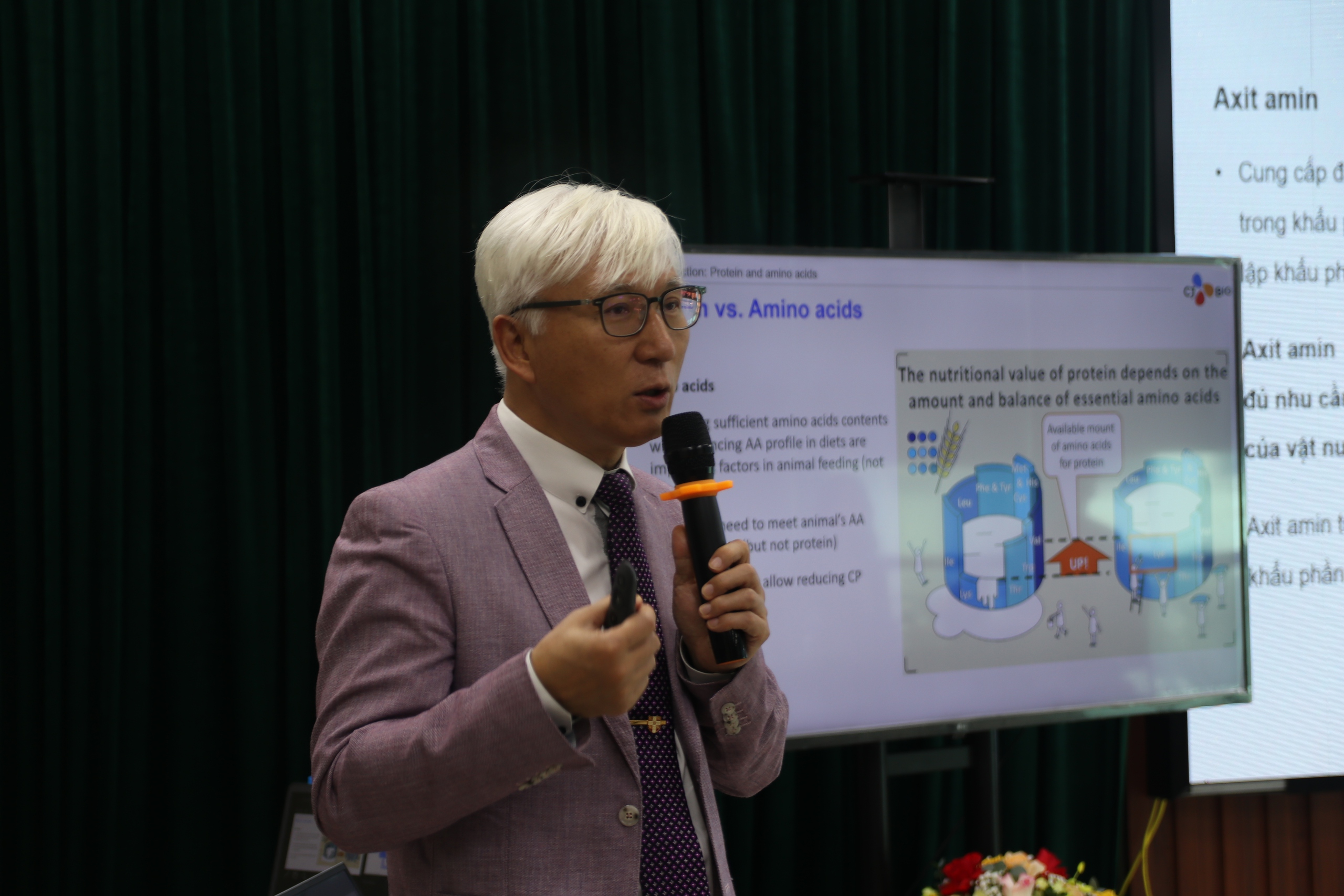
Dr. Kim Jae Cheol emphasized that pigs grow well thanks to amino acids, not crude protein. Photo: Nghia Le
In fact, livestock do not really need protein but amino acids, especially pigs. When pigs digest protein in food, this process is only to separate the amino acids needed to synthesize protein, thereby forming muscle.
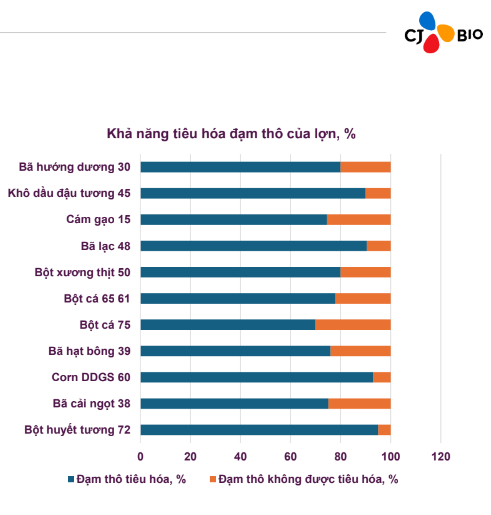
The chart shows the digestibility of crude protein in pigs from different feed sources. Each type of feed has a different ratio of digestible and indigestible crude protein. Understanding the digestibility of each type of feed helps farmers choose the right ration, balance amino acids and minimize waste. Photo: NVCC
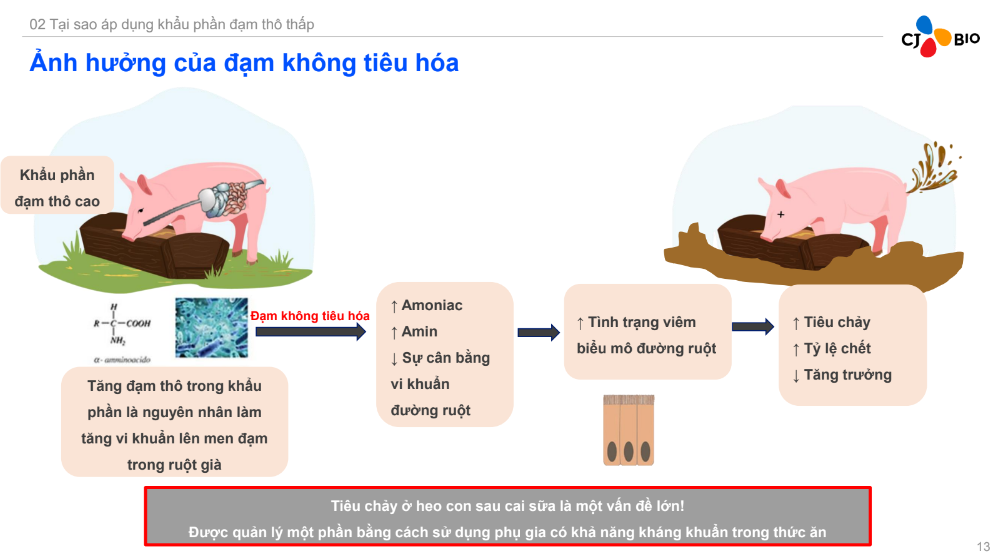
The image shows that applying high crude protein diets to pig farming will lead to many unpredictable consequences. Understanding the principle of applying low crude protein will bring many benefits in sustainable farming. Photo: NVCC
Therefore, to optimize muscle growth, the diet needs to provide a complete and balanced supply of amino acids that the pig's body requires. If there is a deficiency of amino acids, the animal will not be able to develop optimal muscle, no matter how high the protein content of the diet.
Currently, to optimize nutrition for pig farming, researchers have identified four essential amino acids: Lysine, Methionine, Threonine and Tryptophan, which are commonly used in diets.
In addition, Valine and Isoleucine also become the next limiting amino acids in low crude protein diets, providing effective nutritional supplementation without increasing crude protein intake.
The addition of Histidine, Leucine and Phenylalanine (Phe) allows for further reduction of crude protein while still meeting the nutritional needs of the animals. As a result, the crude protein (CP) ratio can be reduced to 16% in the piglet stage, 14% in the grower stage and only 11% in the finisher stage, ensuring strong and sustainable growth of pigs.
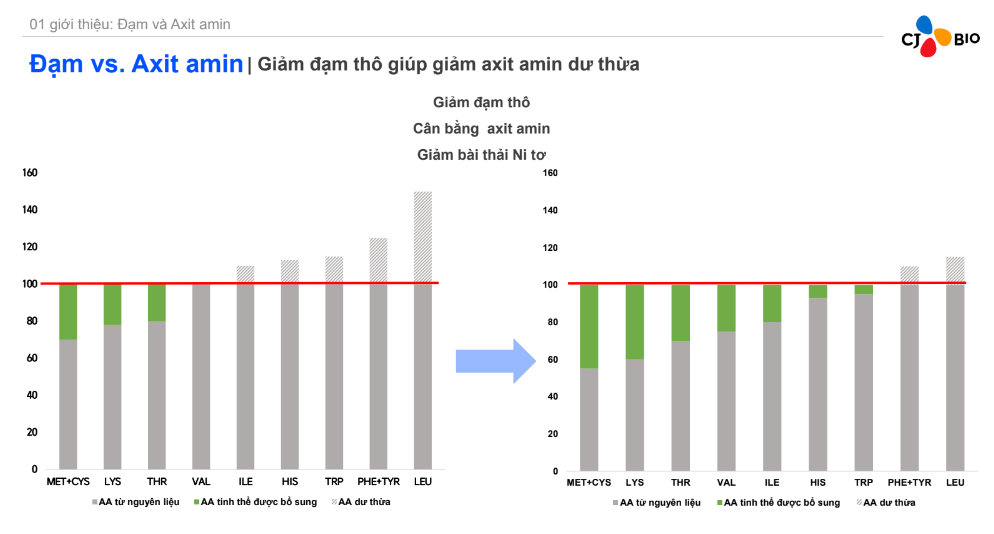
The diagram illustrates that balancing amino acids in livestock diets helps reduce nitrogen excretion into the environment, thereby contributing to reducing greenhouse gas emissions and protecting the environment more effectively. Photo: NVCC
The diagram on the left illustrates the traditional high protein diet model. To meet the required amino acid requirements (red line), farmers often supplement protein at high levels. However, the pig cannot accumulate amino acids beyond the required level, so the excess amino acids (those above the red line) must be excreted, releasing nitrogen gas and contributing to the greenhouse effect.
Meanwhile, the chart on the right shows a solution to balance amino acids by reducing the crude protein ratio in the diet. This method still fully meets the growth needs of the pig without creating a large amount of excess amino acids. As a result, the pig emits less nitrogen, helping to reduce greenhouse gas emissions and protect the environment.
Why should low crude protein feed be applied in pig farming...
Before talking about the benefits of using low crude protein diets, we can clearly see the effectiveness of low crude protein diets in the economic problem, which everyone in the livestock industry is interested in.
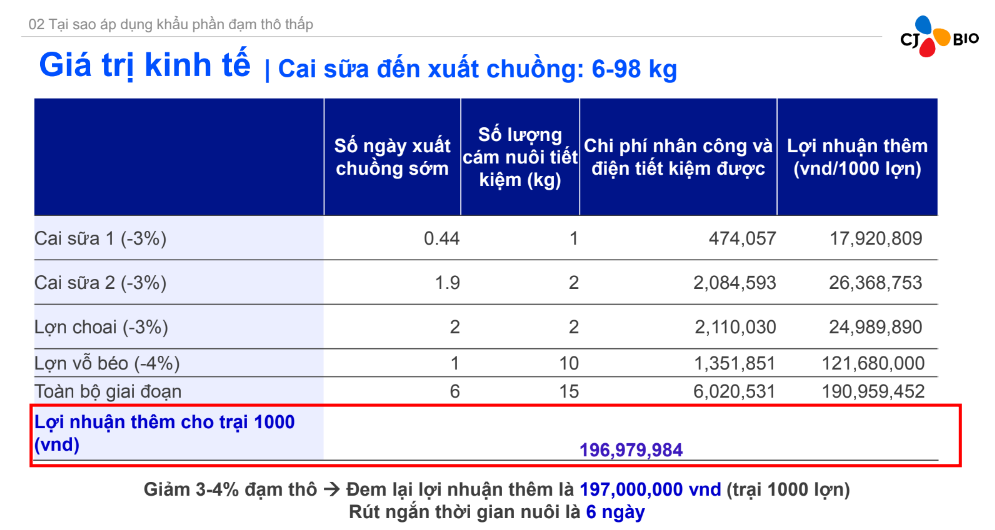
The economic problem of reducing 3-4% crude protein in the diet of piglets to fattening pigs from 6 - 98kg, brings an additional profit of nearly 200 million VND for a scale of 1000 pigs, in addition to shortening the time to market by 6 days, with immediate effect. Photo: NVCC
Specifically, for a farm of 1,000 pigs, applying a low crude protein diet can bring additional profits of up to nearly 200 million VND per year. Looking at each stage, reducing crude protein not only helps save feed but also ensures rapid weight gain, especially in the fattening stage with a 4% reduction in crude protein, creating a significant additional profit of up to more than 121 million VND. This shows that reducing crude protein not only brings high economic efficiency but also optimizes resources in livestock farming.
In addition, reducing crude protein also poses a sustainable economic problem for farmers. With this diet, feed costs are significantly reduced, while shortening the farming time, helping to reduce labor costs, electricity and water and other additional costs, leading to increased net profits.
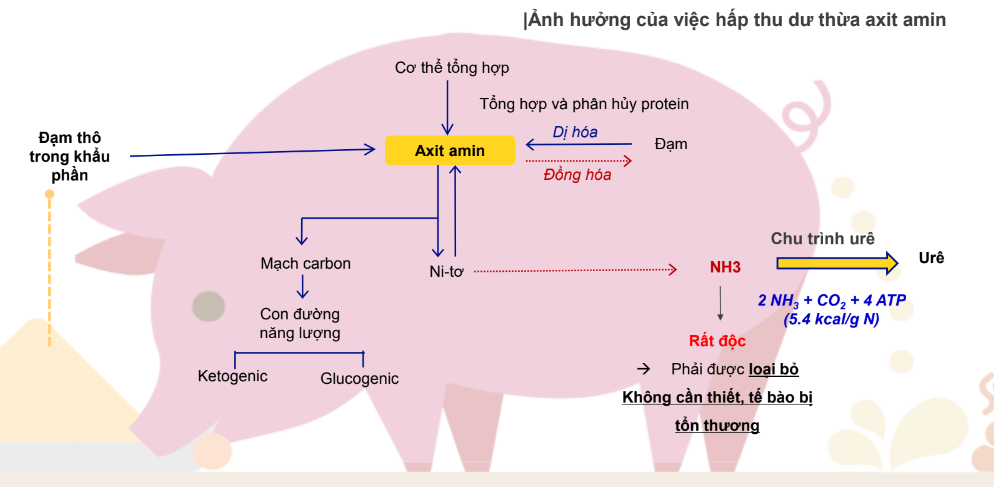
Illustration of how amino acids work in the body of a pig and how the use of high crude protein leads to excess amino acid intake affecting the environment. Photo: NVCC
As of June 2024, the total pig herd in the country reached 25.549 million, of which 3 million were sows. Vietnam currently ranks 5th in the world in terms of the number of pigs and 6th in pork production. However, the majority of livestock farms are still small and medium-sized, with limited waste treatment technology, not meeting environmental protection requirements in the context of strong livestock development.
According to the Vietnam Livestock Association, the total CO2 emissions from the livestock industry by 2023 will reach 20.5 million tons, contributing significantly to climate change. The livestock industry in Vietnam alone, with its high density and large scale, accounts for 10-18% of the country's total greenhouse gas emissions. In particular, statistics show that up to 432,000 tons of CO2 are emitted from pig and poultry farms each year, putting great pressure on the environment.
“When crude protein is reduced in the diet, the amount of nitrogen released during digestion is also reduced, thereby limiting the formation of ammonia (NH3) and other greenhouse gases. This not only helps reduce environmental pollution around the farm but also contributes to reducing pressure on the global environment. This simple change brings dual benefits, both increasing livestock production efficiency and supporting sustainable development goals,” said Dr. Kim Jae Cheol, Director of the Asia-Pacific Technical Solutions Center.
The application of a low crude protein, balanced amino acid diet brings many practical benefits, making pig farming simpler and more efficient. First, this diet reduces the energy requirement needed to excrete excess amino acids, allowing animals to focus their nutrition on the growth process without burdening the digestive system. As a result, pigs can grow steadily and healthily without the need for growth-stimulating antibiotics, creating cleaner, safer products for consumers.
In addition, low crude protein diets also help reduce nitrogen emissions, a major contributor to environmental pollution in livestock farming. When crude protein is reduced in the diet, the amount of ammonia released from digestion is also reduced, helping to keep the barn environment cooler and reducing heat stress for pigs. This is especially important in hot and humid climates like Vietnam, helping to reduce the risk of disease and improve animal health.
In addition, this diet also brings clear economic benefits to farmers. By optimizing the diet, reducing feed costs and additional costs, farms can save significantly while still achieving high livestock performance. This is the solution to simplify the livestock process, increase efficiency without increasing operating costs.
Since 2023, the Ministry of Agriculture and Rural Development and the Institute of Animal Husbandry have begun focusing on research on reducing protein levels in pig feed to reduce greenhouse gas emissions in livestock farming.
The Animal Feed Association expects the results of the project to be a scientific basis for developing Vietnamese Standards on animal feed in the new situation and a basis for the government to issue appropriate regulations on protein levels in feed for livestock and poultry.
Source: https://danviet.vn/loai-thuc-an-gi-giup-nguoi-chan-nuoi-bo-tui-them-200-trieu-dong-moi-1000-con-lon-20241102192219266.htm











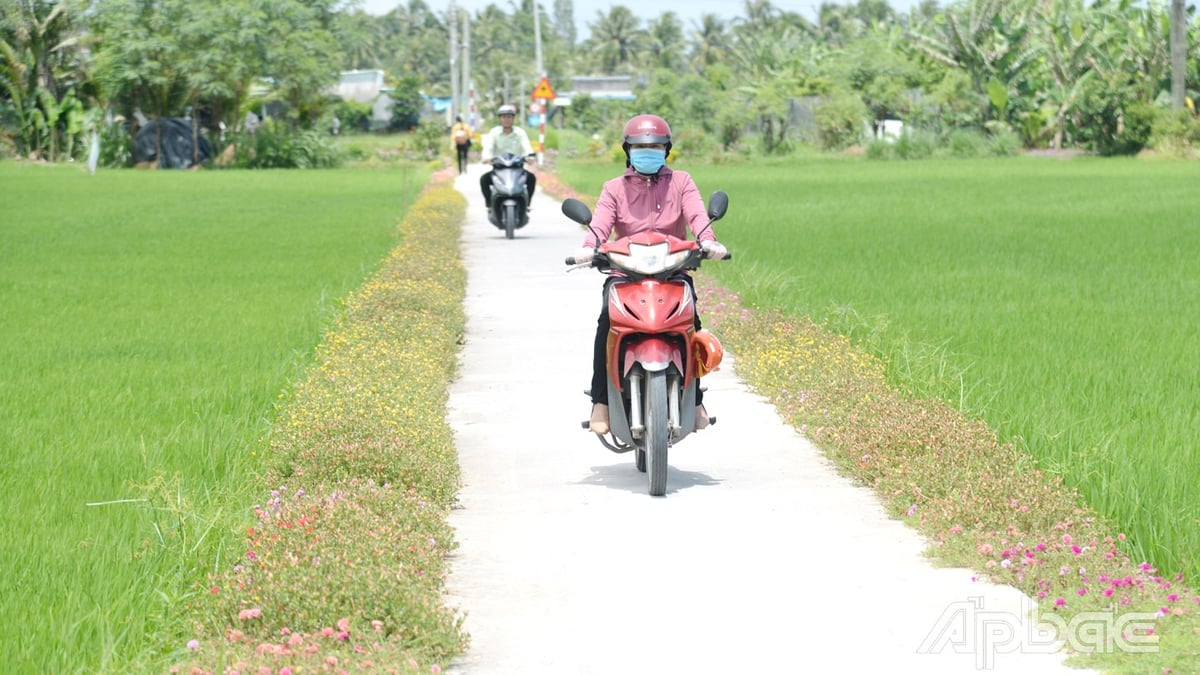

























































































Comment (0)